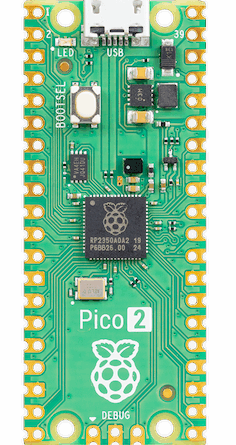Raspberry Pi Pico
🌟 Introduction
The Raspberry Pi Pico is a microcontroller board based on the RP2040 chip developed by the Raspberry Pi Foundation. Unlike the more powerful Raspberry Pi computers, the Pico is designed for embedded systems and physical computing projects where low power consumption, fast I/O, and precise control are essential.
Launched in January 2021, the Raspberry Pi Pico brings affordable and accessible microcontroller programming to hobbyists, students, and professionals alike.
📦 Specifications
- Microcontroller: RP2040 (Dual-core Arm Cortex-M0+ processor, up to 133 MHz)
- RAM: 264 KB SRAM
- Flash Memory: 2 MB onboard QSPI Flash
- GPIO Pins: 26 multifunctional GPIO pins
- Communication Interfaces: I2C, SPI, UART, PWM
- USB: USB 1.1 Device and Host support
- Power Supply: 1.8 – 5.5V input via micro-USB or VSYS pin
🧭 Raspberry Pi Pico Pinout Diagram
Here is a basic pinout diagram to help you understand the layout and functionality of the Raspberry Pi Pico:

Image Source: Raspberrypi.com
Each of the 40 pins on the Pico has multiple possible uses. Some of the key pin categories include:
- GPIO Pins (General Purpose Input Output)
- Power Pins (3.3V, GND, VSYS)
- Analog Inputs (ADC0 – ADC2)
- Communication Pins: I2C (SDA, SCL), SPI (MISO, MOSI, SCK, CS), UART (TX, RX)
- Debug Pins: For SWD (Serial Wire Debug) for advanced programming/debugging
✅ Key Benefits of Raspberry Pi Pico
1. Low Cost and Readily Available
With a price tag under $5 USD, the Pico makes embedded development more affordable than ever.
2. Highly Programmable
- Supports C/C++ and MicroPython, making it versatile for both low-level and beginner-friendly applications.
- Excellent documentation and SDK support from Raspberry Pi Foundation.
3. Compact and Efficient
- Small footprint: Ideal for wearables, robotics, or portable electronics.
- Low power consumption is great for battery-powered projects.
4. Rich I/O Options
- 26 GPIO pins for digital input/output.
- Built-in support for analog reading (3 ADC channels).
- PWM support on all GPIOs.
- Multiple UART, I2C, and SPI interfaces make it perfect for communicating with sensors and other devices.
5. Dual-Core Processor
- Enables parallel processing – e.g., reading a sensor on one core while controlling an LED on the other.
6. Real-Time Performance
- Excellent for time-critical applications such as motor control, signal generation, and real-time data acquisition.
7. Educational Ecosystem
- Huge community support, extensive tutorials, and books.
- Ideal for learning embedded systems, automation, and IoT.
🛠 Common Projects with Raspberry Pi Pico
- DIY weather stations
- Robotics controllers
- Home automation modules
- Sensor data loggers
- Wearable electronics
- Game controllers and MIDI devices
📌 Conclusion
The Raspberry Pi Pico is a small but powerful board that’s transforming the microcontroller landscape. Whether you’re a hobbyist trying your first project, a student learning to code, or a professional prototyping a product, the Pico offers flexibility, power, and ease of use — all at a remarkably low cost.
It truly represents the democratization of embedded development.
Would you like this article formatted as a downloadable PDF or shared as a blog post layout? I can also generate a custom pinout image if needed!

